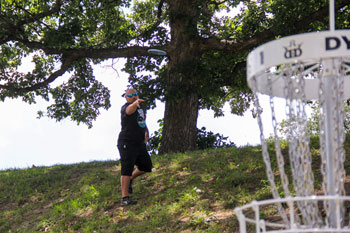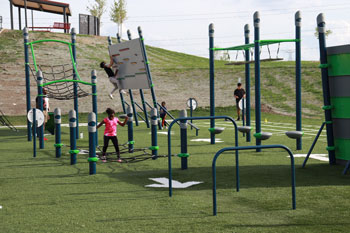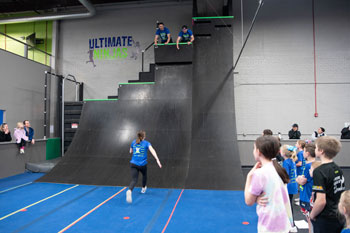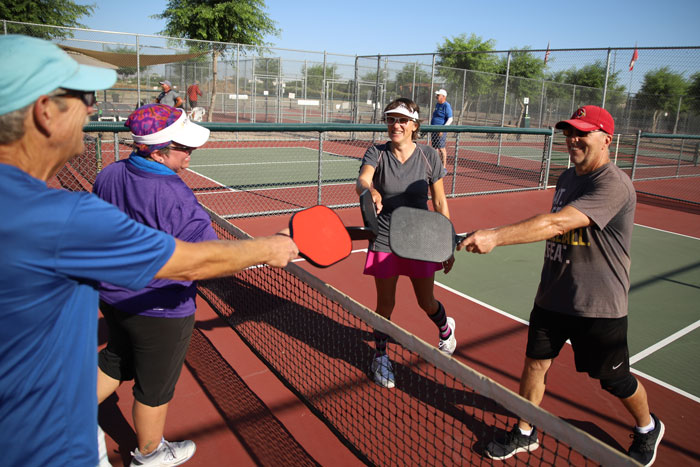Whether it’s fashion, food, music or other various pursuits and pastimes, there are always trends. Some of these catch fire and burn out, while others seem to stick around for the long haul. Sports and recreation activities are no different; the tried and true seem to endure, but there are always new activities out there vying for their own piece of the pie, and it’s up to recreation directors, facility operators and fitness providers to experiment with new offerings and see what sticks.
Pickle-Mania
First, we give due to what’s likely the biggest sports and rec trend to come along for some time, and that’s pickleball, continuing to rack up new enthusiasts at an impressive rate. The nonprofit USA Pickleball provides guidance and infrastructure for the sport’s continued growth and development. Their Annual Growth Report showed that at the end of 2022, 1,557 new locations were added to their “Places2Play” database, reflecting the number of USA Pickleball-registered facilities in North America. This increased the total to 10,724 locations.
“We attribute some of pickleball’s growth to the fact that it’s easy to learn and get a game going, especially compared to other sports,” said Melissa Zhang, director of communications and content at USA Pickleball. Another attractive quality is that it’s easy for people of all backgrounds, skill levels and ages to play with one another, so everyone in the household is included. “There are very few sports that have this natural, effortless multigenerational aspect.”
Zhang said they have a wide range of members. “As the national governing body, we have a responsibility to grow the game at the recreational and amateur level first and foremost. With that being said, we also support the professional level of pickleball. That just isn’t our main focus or priority, as it may be for professional tours or leagues.”
The organization has a network of volunteer ambassadors who’ve pledged to support the sport and USA Pickleball in their area. “Our network of nearly 2.000 ambassadors are absolutely our boots on the ground, and one of the many roles they fulfill is helping their local communities with getting programs going,” said Zhang, adding that they provide advice and support to numerous public and private entities looking to start pickleball programs.
Facility development is also a focus. “USA Pickleball is directly involved in over $200 million in facility projects for construction, targeting late 2023 and 2024,” said Zhang. “These projects include about 4,000 courts total, consisting of private ‘dink and drink’ facilities, public municipalities and large-scale sites with upward of 40 to 70 courts in one site.”
They also offer a grant program, last year awarding 72 Community Grants and 66 Youth/Collegiate Grants, allocating more than $41,000. “We’ve seen these grants allow communities to invest in the sport at the grassroots and youth level especially, to great effect.”
Many of us think of pickleball being played primarily by “older” adults, but according to USA Pickleball, the average age for all players dropped to 38 years old in 2021, with the fastest growing demographic being those less than 24 years old. USA Pickleball has developed free training and downloadable resources for youth program providers to be used in schools, parks, youth centers and pickleball facilities. And NIRSA – leaders in collegiate recreation – has teamed up with Dynamic Universal Pickleball Rating (DUPR) to grow pickleball on college campuses, offering equipment, promoting tournament opportunities, providing grants and growing the number of pickleball sport clubs.
Life Time Fitness has more than 160 “athletic country clubs,” and since early 2022, they’ve constructed pickleball courts at a rate of five new permanent courts each week—many with viewing areas, stadium seating and social lounges, according to Senior Public Relations Specialist Dan DeBaun. They now have more than 540 courts—180 of them outdoor and more than 350 indoor. “(We) intend to exceed 1,000 by the end of 2024. Life Time is the largest owner and operator of pickleball courts.”
DeBaun said they continue to see growth across their pickleball lessons and clinics. “From beginner to advanced offerings, these fill up and sell out almost immediately. We’ve also seen more than 300% growth in pickleball participation on our courts over the last year.”
Leagues and tournaments have also proven popular. “We’ve teamed up with the Professional Pickleball Association and Major League Pickleball to host tournaments at our athletic clubs this year. Each bring thousands of players and spectators to our locations. We’re also hosting our own Pickleball Classic tournaments and plan to expand this further.”
Sue Omanson is the community development manager at the Naperville Park District, serving the nearly 150,000 residents of Naperville, Ill. She said that over the past five years they’ve built 18 dedicated pickleball courts and offer tennis courts at five parks that are lined for pickleball as well. The outdoor courts are free and well-utilized. “Players are advised to follow the posted rules and etiquette of the sport in terms of rotating play, as there are no reservations taken for court use. We offer Pickleball Basics and Skills & Drills classes indoors in spring, fall and winter.”
Indoor courts are located in their rec center gyms, either for classes or pickleball open play. “Our gym play is available for a fee and is first come, first served.”
Throw Long & Prosper
Disc golf is another sport continuing to explode in popularity with no signs of slowing down, and Omanson said they have an 18-hole course at one of their parks. “Disc golf is popular and is enjoyed by a wide range of ages; parents bring their kids, and there are seasoned players past retirement age as well.”
Spencer Huard is the creative services manager at Naperville Park District, and he’s a big fan of the course and its beauty. “I always see new things when I’m out there and different ways to play the holes, which keeps it fresh.”
He brings his son along and said the vibe is great, with no intimidation. “People are conscious to let better players through and to not push people who are amateurs. Everyone’s saying hi, giving advice, looking for advice. It’s really wonderful.”

The course is available for drop-in play, and while the district doesn’t offer any tournaments, sometimes players organize their own events.
In fact, it’s common for disc golf enthusiasts to build a community and feel ownership for their favorite courses. Kansas City Disc Golf Inc. (KCDG) is a nonprofit organization with a mission to “educate and engage the greater Kansas City Metropolitan area in the sport of disc golf.” There are currently 53 courses around KC Metro, which includes both Missouri and Kansas, and most of these are park or municipal courses with a few private ones, according to Pete Cashen, Sargent at Arms at KCDG.
The organization promotes the history, rules and health benefits of the sport. They organize and support events specifically to introduce new players to disc golf, and work with other nonprofits to organize and facilitate charitable events. And they work to engage youth in the sport. “We’re starting to see lots of kids out playing, families out playing—there’s a lot more family-friendly courses that are shorter and easier. We have pros come through and put on clinics,” said Cashen.
The sport helps develop healthy habits in kids, as well as camaraderie and sportsmanship, and it’s linked to lessons in math, science and civics. Cashen described teaching kids about scoring, about erosion on the courses and different types of trees, bushes and grasses. “We teach the kids about not just throwing but how to find your angles when you throw a disc, things like that.” But he also pointed out that more people in their 50s and 60s are coming back to the sport.
KCDG, which boasts around 400 members, also oversees leagues and tournaments throughout KC Metro. “The park districts ask for help, and we’re very good partners with our parks,” said Cashen.
In fact, the group assists area parks and rec departments with the creation, installation and upkeep of courses. “A lot of these parks are strapped for money, and we help on workdays, before the season and especially after storms, picking up branches or trimming trees.”
He said they’d just finished a tournament they’d organized, with players from around the country participating. “We averaged 80 volunteers a day for a four-day event, and the past few weekends there were probably 20 or 30 people out there weeding.”
Currently, disc golf is a $200 million+ industry, projected to reach $500 million in 2028, according to Cashen, who discussed the professional disc golf organizations, tournaments and networks out there. Some professional players are now making seven figures, through tournament earnings and sponsorship agreements.
Some other stats from UDisc, an app for disc golfers:
- There are over 14,000 courses worldwide and around 9,500 in the U.S., with 4.3 courses being installed per day in 2022.
- In the U.S., 254 million people can play within 6.2 miles of their residence.
- 90% of courses are free to play.
- 90% of players introduced someone to the sport in 2022.
- Nine-hole courses are being built at nearly twice the pace of 18-hole courses.
Test Yourself

Ninja and obstacle courses continue to gain popularity since the success of the American Ninja Warrior television series. Ultimate Ninjas is a private facility with several locations, featuring courses and classes designed and led by professional ninja athletes. The Naperville, Ill., location offers a variety of obstacle courses for kids featuring upper body and agility/balance obstacles, as well as a gym area for basketball, soccer, floor hockey and space to run.
Jesse Labreck is general manager of this location and she has competed multiple seasons on American Ninja Warrior, being the first rookie female to qualify for the Las Vegas Finals. She believes that ninja courses are becoming more mainstream for both rec and fitness. “We see a lot of kids and adults who take classes or come to open play who just enjoy ninja for fun. We adapt to anyone. We have a grandmother, mother and daughter who all take classes and train here. We’re able to create obstacles and challenges for any skill and age level.”
She said they offer 60-plus obstacles that they rotate through. “I would say about 20-plus are up at one time, and we change the gym obstacles weekly.”
Ninja classes for kids include preschoolers to advanced, helping build confidence while promoting other skills important in all sports. Additionally, “we have a full team of Elite Ninjas that take it more seriously and compete in leagues around the country”, said Labreck.
Many who participate in classes in camps come back for more. “We have over 400 kids in our program who return every week, sometimes multiple times a week.”
There are also open-play times offered. “This is where we get new people to come out and try the gym, and definitely those families who want to do the obstacles but can’t commit to weekly classes.”
Birthday parties and hosting packages—with full access to the courses—are another way to bring in new visitors.
Adults are getting into the ninja craze as well, and Ultimate Ninjas partners with a group offering adult fitness opportunities. “We have obstacle fusion classes that include the obstacles in the workouts” said Labreck, and open gym times as well. There are also competitions hosted by the facility, including World Ninja League (WNL) competitions. WNL is an obstacle course organization with a mission to “grow ninja into a properly regulated sport from the recreational to the professional level.”
More rec programs are also adding ninja offerings to their playbooks. In Lawrence, Kan., the parks department offers yearlong ninja warrior programs for children of all skill levels. The Bolingbrook, Ill., parks department has the Ninja Zone. And Grit Ninja—a private facility with four locations in the East—partners with parks departments by bringing their equipment out to “turn our parks into unique ninja warrior obstacle courses,” offering classes led by professional coaches.
Many parks are installing their own outdoor courses. “We have a challenge course at one of our newest parks,” said Omanson. “This ninja-style course is well-used in a park that also offers many other recreational activities.”
E-Arena Era

Esports is a collective term for competitive electronic gaming, and leagues and events are booming in communities across the country.
At University of Illinois, Chicago (UIC) they offer the Gauntlet, a space offering individuals the opportunity to compete in various esports, on PCs or gaming consoles. “Drop-in play is our most popular use for esports, where students utilize our space to play against their friends or in public lobbies against players all over the world,” said John Manning, assistant director of programs at UIC. “We had over 21,000 hours of play during the last fiscal year and over 12,000 participations.
“The UIC Competitive Gaming Club is very popular as they have 74 active competitive team members across multiple game titles, and 1,000-plus members in their virtual community,” continued Manning. “They compete in leagues, tournaments, public games and friendly matches against other university teams. With the growth in esports there are increasingly more opportunities for the club to get involved in competing against other university teams in controlled leagues.”
UIC spends two to four hours a week ensuring game titles, platforms, hardware drivers and equipment are current. “Hardware is more challenging as the standards change often, but we do have all PC devices on an upgrade cycle so we can maintain competitive advantage for our users,” said Manning.
He added that esports tend to be a topic continually discussed at campus recreation conferences and networking opportunities. “With the growth of the industry, more departments are taking steps to include that type of programming in some capacity (competitive or recreational) as part of their offerings.”
Esports are also gaining traction in terms of a parks-and-recreation activity, according to CivicPlus, a firm specializing in helping governments optimize digital interactions for residents and staff. The Lombard, Ill., Park District offers opportunities for players of all ages to participate in esports through a partnership with an esports tournament platform specializing in working with organizations to provide esports leagues and infrastructure.
Climbing, Golf & More
Climbing walls also continue to be popular for both recreation and fitness, and DeBaun said that more than 60 Life Time locations offer them for classes and open climb.
The Stephens Family YMCA in Champaign, Ill., offers a climbing wall, with classes for preschoolers to adults. “I’d say we fill out 95% of our open spots each month,” said Jacob Meyer, youth sports director. There are also private sessions, and Meyer said their advanced adult classes are really popular currently. “We weren’t going to run any in June, but because we had such an interest, we opened up one for them to participate in.”
Meyer said they change up the routes frequently and have different challenges that the kids especially like. “They’ll blindfold them as they go up the wall or give them a heavy backpack, tell them they can only use certain colors, or they’ll put objects on certain parts of the wall that they have to go and get. Our climbing staff do a really good job of keeping people engaged, and even if they’ve done the class before, we have people who come back and still enjoy it and move up in our classes.”
Back at UIC, Manning was asked about any other trends. “In addition to pickleball, golf has grown since the pandemic. This is a market often untapped by campus recreation across the country, particularly on urban campuses, but is a key trend to monitor moving forward as 18-to-34 year-olds are the sport’s largest age group.”
And does UIC have a ninja course? “We don’t have our own obstacle course, but have rented this type of activity for use during our kick-off events at the start of the semester, and it always had a line of students interested.”
Some trends are brand new while others have just been waiting for their day in the sun. RM



